There are a few lures, beside topwater ones, which bring the same joy and adrenaline rush to fishermen, when sea predators attack. Fishing with poppers, walkers and their combinations is one of the most spectacular processes. It makes the fish chase the lure, get annoyed, miss, jump out of the water, catch up with the prey again and again. Ultimately, a breathless fisherman with a spinning rod feels the bite.
However, you will hardly persuade the fish to attack the lure, if you just go to the Adriatic coast and cast a walker into the sea anywhere and anytime. adriaticnature decided to discuss the subtleties of this fishing technique with the expert, Miro Jovica, who lives in the city of Ploče (Croatia) and uses all kinds of lures in his fishing practice, but remains a fan of catching predators from the surface of the sea.

(Miro Jovica with a leerfish caught on a walker. Foto © Miro Jovica)
– Hello, Miro! Thanks for getting around to a conversation with us. I want to talk to you from the perspective of an amateur fisherman on the Adriatic Sea, who really wants to catch predators with topwater lures. Tell me, please, which predators should fishermen expect in the first place?
Hello! I can surely say that chances are high that the fishermen, who get to the shores of the Adriatic Sea and are fond of fishing with topwater lures, will catch sea basses. European basses are active throughout the calendar year. These fish are the trophy that can be caught by a fisherman with a spinning rod in the first place.
I’m really lucky to live close to the place, where the Neretva River flows into the Adriatic. And this place is one of the best for fishing on both sides of the sea. I have the opportunity to fish efficiently in any season.
In addition to sea basses, bluefishes and leerfishes adore topwater lures and are frequently caught in different seasons. And, of course, little tunnies, bonitos, and many others will never pass these lures by.
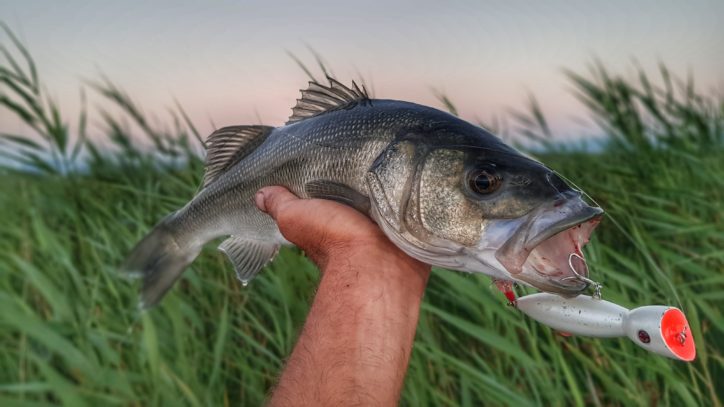
(Seabass caught on a popper. Foto © Miro Jovica)
– Each of the mentioned predators has its own approach. Let’s talk about the peculiarities of fishing, and start with the seabass. Which lures should fishermen have in their kits and which are the right places to search for seabasses?
Of course, the choice depends on the specific situation. At some point, the European bass prefers active playing of the lure, and casting a small walker with its aggressive animation, alternating with pauses, makes the sea bass attack. And, sometimes, vice versa, the seabass prefers large lures and their leisurely playing. Even though I really want to give you god advice, there are no five or six versatile lures for catching this predator. This question is one of the most frequently asked, and, truth be told, I can’t give a clear-cut answer.
As for the lures in my kits. When my goal is to catch a seabass, I take poppers and walkers, ranging in size from 45 to 210 mm.
The seabass is a very aggressive predator, and it’s rather easy to instigate it to attack, when it is chasing or guards “its” territory against competitors. As for me, the most precious and spectacular moments that I keep in mind for a long time are the moments, when the seabass attacks the topwater lure for reasons of protecting its territory.
Of course, river mouths, as well as shallow bays with thickets of sea grass are the best places to search for this predator.

(Seabass caught on a surface lure. Foto © Miro Jovica)
– Of course, the bluefish is considered to be one of the most aggressive predators of the Adriatic. Besides, it can be really large. What is the difference between catching bluefish and catching other fish that willingly attack topwater lures?
The bluefish is definitely a great “sports” joy, due to which the number of anglers who are fond of fishing with spinning rods is increasing. These are very aggressive schooling fish. I adore this predator, and catching a fish weighing from 4 to 6 kilograms occurs rather frequently.
Bluefishes are wonderful powerful opponents attacking lures with excitement and amazing jumps while chasing them. In my parts, these predators are present almost throughout the year in large numbers.
Due to their “friendly” nature, they can attack lures even when they don’t eat actively. If you want the bluefish to bite your trebles, you should work with these lures more actively than when fishing for the seabass.
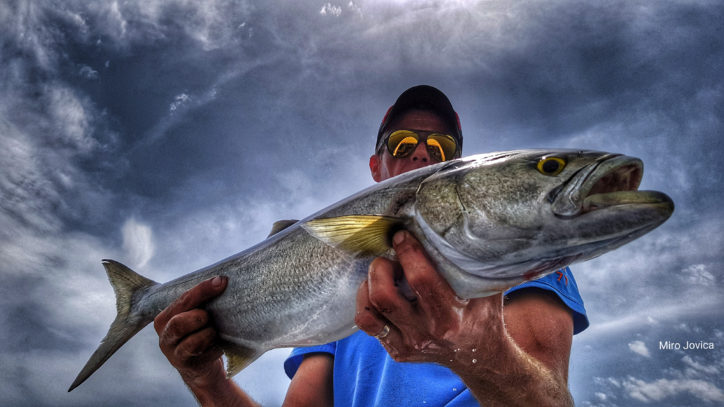
(Bluefish caught on a surface lure. Foto © Miro Jovica)
– The leerfish is a predator. Catching specimens weighing more than ten kilograms is not uncommon. What should the fisherman understand in order to provoke an attack of this strong fish?
The leerfish is one of the most powerful predators that can be caught with the help of topwater lures on the Adriatic Sea.
Chances are high that you catch leerfishes twice a year – in spring, when they swim up to the surface of the sea, and in autumn, when they are very aggressive, and swim very close to the shore. It’s easy enough to catch this predator, when its schools swim near the surface.
But the fisherman should know a thing or two about the techniques used by the leerfishes to attack their potential preys. Most often, the leerfish attacks knocking the smaller fish off balance from the side, pushing it with its body or tail, and then it turns around and eats the prey at once. The fisherman should know about such behavior of the predator in order to present the lure properly. One shouldn’t expect the bite at the first attack, but the lure should be left alone after the attack, with a minimal playing, and the leerfish will be back to complete the plan.
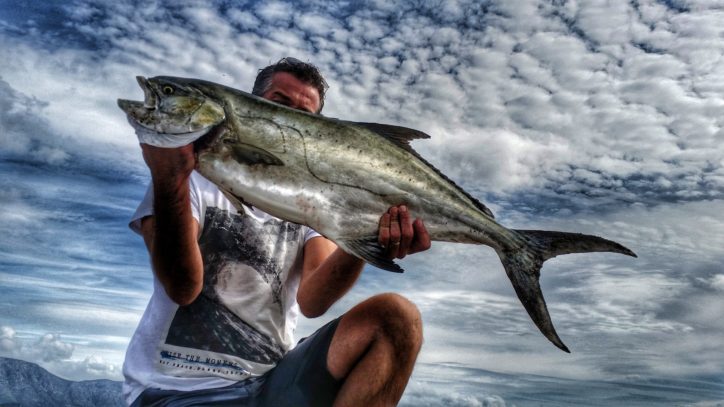
(Leerfish caught on a surface lure. Foto © Miro Jovica)
– Which size of topwater lures do you consider to be versatile, if any, and how long are the walkers (walk the dog’ lures) and poppers in your kit?
Depending on the fishing target and the season, I take topwater lures of various sizes. Most often, I use the models about 100 mm long, I would probably say that they are the lures of the versatile size. I rarely use smaller “topwaters”; the ones 120-130 mm long are my favorite, such as Sakura Naja 125, Lucky Craft Sammy 128, and other lures of similar shapes and sizes. Although I have a lot of poppers of different types, I decided for myself that their versatile size is about 100 mm.

(Seabass caught on a popper. Foto © Miro Jovica)
– Does it make sense to purposefully try to catch other fishes with topwater lures?
Of course! A huge number of fish species are interested in topwater lures. For example, in shallow bays you can catch both weevers and gilthead breams. Little tunnies, bonitos and so on go without saying. Topwater lures always provide you with an unforgettable experience!
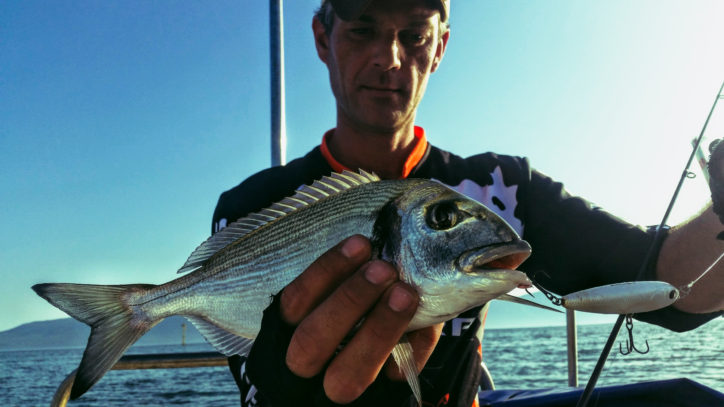
(Gilthead bream caught on a walker. Foto © Miro Jovica)
– Walkers and poppers. When and in which situations do you choose the former or the latter ones?
When I purposefully catch the seabass, I use poppers when the fish is not so active and doesn’t respond to other lures, but I’m sure that it swims around the chosen area.
The European bass guards its territory, and may see the popper as the ting that prevents it from chasing quietly, and, thus, it tries to get rid of the intruder.
Poppers, as well as walkers, are great lures for leerfishes. But I often catch these predators with long plugs.
When I try to catch bluefishes dawn-to-dusk, most often, I use fast walker retrieve. But the night is the right time to use poppers, when a more careful playing of the lure (often with long pauses) is required.
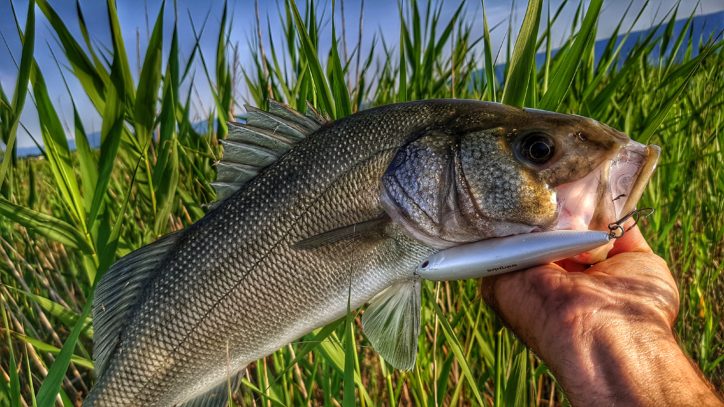
(Seabass caught on a walker. Foto © Miro Jovica)
– What are your favorite lure colors? What should one understand when choosing the color of walkers or poppers in the process of fishing?
Most often, I start my fishing with topwater lures tinged with white or light colors. In my opinion, white is the most versatile, and, most often, predators attack lures tinged with some shades of white. Unpainted, “transparent” lures that refract light show solid performance as well; they are especially efficient when the sea is rough. “Glistening” lures are also efficient. And if nothing of the above mentioned lures works, it’s time to experiment with all other colors.
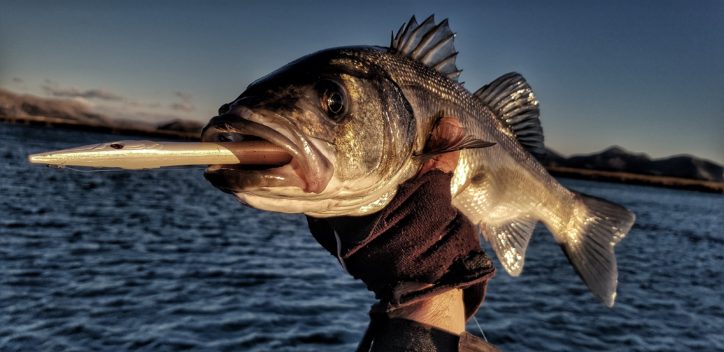
(Seabass caught on a white walker. Foto © Miro Jovica)
– You often fish with topwater lures from a boat. Are there any obvious advantages beside the fact that you can cover a large water area from a boat?
The boat gives me the opportunity to fish in the places where I can be alone, and devote 100 percent of my time to fishing. And yes, of course, when I fish from the shore, I often can’t get to shallow bays, depths or other interesting places that become accessible when fishing from a boat.
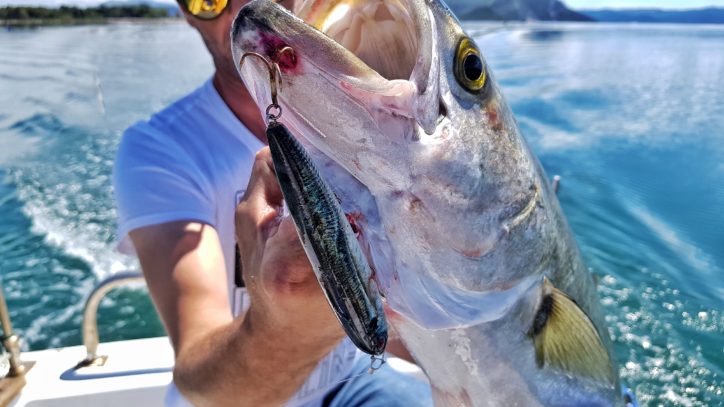
(Bluefish caught on a walker. Foto © Miro Jovica)
– What can you wish adriaticnature readers?
Let yourself go fishing and you will find the best way to forget about your everyday routine.
Don’t become obsessed with catches, enjoy physical activity and unity with nature. Catches are bound to come over time, as a mandatory component. One day at a time!